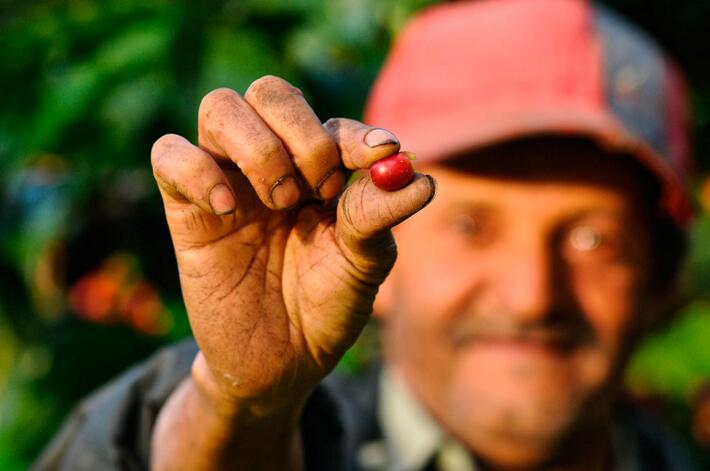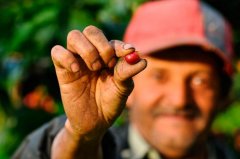Why does the candle taste good in Sidamo? Do the coffee beans in Sidamo taste good?
Why does the candle taste good in Sidamo? Do the coffee beans in Sidamo taste good?

Sidamo grows in the southernmost Ethiopian plateau between 4600 and 7200 feet above sea level (Sidamo province). It is a famous boutique coffee area in southern Ethiopia, bordering Kenya, southeast of Gemma, just south of the capital, usually sweet and loved by most people. its annual output is about 225000 bags / 60kg, with a smaller bean body than Longberry, with gray in the green, and in the sun drying field in Sidamo. Coffee is placed in hemp net wooden frame, workers take turns in the sun exposure, manual stirring coffee, sun Sidamo is usually marked with G4 exit, washing Sidamo because the treatment process is more perfect, so most of them are exported at G2 level.
The coffee in Sidamo has a variety of flavors. Different soil types, microclimates and countless native coffee species, towering mountains, highlands, plateaus, valleys and plains, diverse topography, and the geology of the area belongs to nutrient-rich, well-drained volcanic soil. the depth of the soil is nearly two meters, and the surface soil is dark brown or brown. The biggest advantage of the area is that the soil fertility is maintained through the circulation of organic matter, using the withered leaves of the surrounding trees or the residual roots of the plants as fertilizer.
The origin of the name: Drima Zede (candle) means "Best Approach" in the local dialect. According to the information provided by the original factory, this Yega Xuefei is a series of tailor-made products developed based on 90 + years of experience. With the support of 90 + technology, Drima Zede only selects the most mature coffee cherries by hand, and the sun drying process takes pains to keep stirring to ensure uniformity. The end result is a very transparent and pure taste, hot and cold varies greatly, and the aromas of fruit, flowers and oak are very attractive.
Origin: 90 + Ethiopia SNNP, Sidama (Hidamo) producing area
Treatment method: insolation
Baking degree: shallow baking
Wet fragrance: fruit fruit, floral flower, oak oak
Flavor: nectarine (nectarine), tropical fruit (tropical fruit), cream (butter), cinnamon (butter)
High-shelf suntan method
Drima Zede means "Best Approach" in the local dialect. According to the information provided by the original factory, this Yega Xuefei is a series of tailor-made products based on 90 + years of experience. With the support of 90 + technology, Drima Zede only selects the most mature coffee cherries by hand, and the sun drying process takes pains to keep stirring to ensure uniformity. The end result is a very transparent and pure taste, hot and cold varies greatly, and the aromas of fruit, flowers and oak are very attractive.
Raw bean information
Sidamo Coffee beans are grayish, thick in some places and small in others, with soft and strong acidity, mellow and sweet and spicy. It is one of the courtyard coffees in the highlands of southern Ethiopia. Unlike ordinary African coffee, Sidamo has clear acidity, smooth taste and delicate floral smell.
Production area: 90+SNNP, Sidama (Sidamo)
Haiba: 1750-2000 m
Treatment method: sun treatment method Natural Process
Variety: Ethiopia native species Ethiopian Heirloom
Shallow baking Light Roast
Wind: floral aromas, nectarines, tropical fruits, blackberries, blueberries, plums, cream, cinnamon
Acidity: medium to high
Baking experience sharing:
Roaster Yangjia 600g semi-direct fire
Using fast frying mode, the furnace temperature is 200 degrees Celsius into the pan, the throttle is set at 3 degrees Celsius for 30 seconds, the firepower is adjusted to 160 degrees, the throttle is unchanged, and the firepower is adjusted once at 150 degrees Celsius. At this time, the bean table turns yellow, the smell of grass disappears completely, dehydration is completed, the firepower is adjusted to 120 degrees, and the throttle is adjusted to 4.
In the 8th minute, ugly wrinkles and black markings appear on the bean table, and the smell of toast obviously changes to the smell of coffee, which can be defined as a prelude to an explosion. at this time, listen clearly to the sound of an explosion point, to 849 "start an explosion, adjust the firepower to 70 degrees, the throttle is fully open 5 (the firepower should be very careful, not so small as to be free of bursting sound), 1: 48" after an explosion, 195 degrees into the pot.
Important Notice :
前街咖啡 FrontStreet Coffee has moved to new addredd:
FrontStreet Coffee Address: 315,Donghua East Road,GuangZhou
Tel:020 38364473
- Prev

Sidamo Sakuran is the champion bean? How to make Sakuran taste better? What are the flavor characteristics?
Sidamo Sakuran is the champion bean? How to make Sakuran taste better? Planting place: only the sun-tanned coffee beans produced by Buku Abel in Hambella producing area are the real Sakuran. Hambella (Humbela) is located in the largest coffee producing area of Ethiopia, GUJI, and the west is opposite the mountain of Yegashefi kochore, which is the highest sub-area in Ethiopia. At present, there are nearly 20% of Hambella producing areas.
- Next

The Origin of the Manor in the Village of Rosa in Ethiopia Gesha Rosa Geisha really originated in the Village of Rosa?
The origin of the manor in the village of Rosa, Ethiopia Gesha Rosa\ does the geisha really originate in the village of Rosa? The Origin and Development of Rose Summer Village the owner of Gesha Village is Adam Overton, a genuine American who was not a coffee shop owner but a documentary filmmaker. And his wife, Rachel Samuel, is Ethiopian and a photographer.
Related
- Detailed explanation of Jadeite planting Land in Panamanian Jadeite Manor introduction to the grading system of Jadeite competitive bidding, Red bid, Green bid and Rose Summer
- Story of Coffee planting in Brenka region of Costa Rica Stonehenge Manor anaerobic heavy honey treatment of flavor mouth
- What's on the barrel of Blue Mountain Coffee beans?
- Can American coffee also pull flowers? How to use hot American style to pull out a good-looking pattern?
- Can you make a cold extract with coffee beans? What is the right proportion for cold-extracted coffee formula?
- Indonesian PWN Gold Mandrine Coffee Origin Features Flavor How to Chong? Mandolin coffee is American.
- A brief introduction to the flavor characteristics of Brazilian yellow bourbon coffee beans
- What is the effect of different water quality on the flavor of cold-extracted coffee? What kind of water is best for brewing coffee?
- Why do you think of Rose Summer whenever you mention Panamanian coffee?
- Introduction to the characteristics of authentic blue mountain coffee bean producing areas? What is the CIB Coffee Authority in Jamaica?

